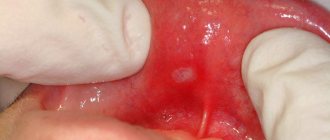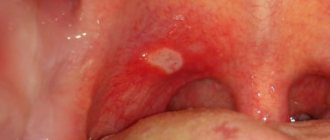Content:
- Description of the disease
- Manifestations of the disease
- How does allergic stomatitis develop?
- Why does it occur
- Establishing diagnosis
- Fighting the disease
- How to reduce the risk of developing the disease
A dental disease in which the integrity of the oral mucosa is damaged - allergic stomatitis - occurs quite often in medical practice. It comes in different forms, so a person cannot always understand what caused the disease and what factors caused its negative symptoms.
Description of the disease
With the diagnosis described, the oral mucosa is damaged, the tissues become very susceptible to all irritants. The incubation period is long. This means that a lot of time passes from the moment the first signs of allergy appear to the manifestation of the disease itself. Because of this, the patient is unable to track the relationship between the symptoms that bother him.
Allergic stomatitis occurs in both children and adults. More often it is diagnosed in people who live in areas with unfavorable environmental conditions.
Causes
The causes of allergic stomatitis can be divided into two groups: contact and substances entering the body (foods, medications, pollen, mold, dust). The first group includes those substances and objects that come into direct contact with the skin and mucous membrane, causing only superficial irritation.
Among such reactions can be identified allergic denture stomatitis, provoked by constant contact with the material from which the denture is made. If the material is not of sufficient quality and is not hypoallergenic, the likelihood of developing allergic stomatitis increases significantly. In addition, pathogenic microorganisms constantly accumulate in the prosthetic bed, the waste products of which can also irritate the mucous membrane. Moreover, even microscopic damage to the mucosa creates favorable conditions for the active development and reproduction of these microorganisms.
Allergic contact stomatitis can also be caused by some medications used in the treatment of teeth and gums, as well as when taking medications that must be kept in the mouth until completely dissolved.
Substances included in the second group cause an incorrect reaction when they enter the human body, manifested in various kinds of rashes on the mucous membrane and soft tissues, itching, burning, and swelling of the tongue. Moreover, such a reaction can be caused not only by antibiotics and potent drugs, but also by antihistamines aimed at relieving a person of allergies.
Various factors can provoke the development of an atypical reaction of the body to a particular substance, ranging from the environment to the period of the menstrual cycle in women. Unfortunately, it is almost impossible to predict the occurrence of allergic stomatitis.
Manifestations of the disease
The disease negatively affects the functioning of the entire body. It doesn’t just cause inflammation of the mucous membranes—it also causes migraines, elevated body temperature, and lethargy. Many people notice dry mouth, severe pain when chewing, which is present even when the integrity of the tissues has not yet been compromised.
Saliva thickens, becomes viscous, more like foam. The gums, tongue, and inner surface of the cheeks may swell. All these symptoms deprive the patient of the opportunity to lead a normal lifestyle.
You shouldn’t wait for the disease to clear up. The sooner her treatment is started, the sooner her health will be normalized.
Symptoms of the disease
For catarrhal form:
- the patient experiences itching and burning;
- xerostomia is observed - dryness in the oral cavity;
- taste sensitivity is impaired;
- eating becomes difficult.
For catarrhal-hemorrhagic form:
- the temperature rises;
- eating is accompanied by pain;
- there is general weakness.
For erosive-ulcerative form:
- the mucous membrane becomes covered with painful blisters, which, when opened, form erosions and begin to bleed;
- soft tissues (tongue, gums, palate) swell;
- lymph nodes enlarge;
- pain appears when chewing and even at rest;
- body temperature rises.
In the ulcerative-necrotic form:
- headache appears;
- appetite decreases;
- eating food is accompanied by severe pain;
- there is general weakness;
- lymph nodes enlarge;
- the mucous membrane is covered with erosions and foci of necrosis.
Also, allergic stomatitis may be accompanied by bad breath and increased salivation.
How does allergic stomatitis develop?
Dentists distinguish three stages of the disease:
- Primary or catarrhal. A person notices a burning sensation in the mouth, drying out of the mucous membranes. There are no ulcers or plaque yet or they are barely noticeable. If treatment is not started, the resulting ulcers will begin to grow.
- Bullous. Bubbles form on the tissues. There is a cloudy liquid inside them.
- Ulcerative-necrotic. The most dangerous stage in the development of pathology. The pain in the mouth becomes very strong, acute, and does not go away even during rest. The mucous membranes of the mouth swell, turn red, and look inflamed. Numerous ulcers are visible on them, covered with a dense gray coating. If you try to remove the top film, the wound begins to bleed.
You can't start a disease. It is much more difficult to treat the ulcerative-necrotic form of stomatitis than the catarrhal form.
Why does it occur
From the name of the disease it is clear that it is allergic in nature. The disease develops in two cases:
An allergen enters the patient's body. As a result, a pathological response of the immune system develops. We are talking about allergies to pollen, medications, mold, and food.- The tissues of the oral cavity come into direct contact with the allergen. This means that the oral cavity has been treated with something (for example, a medicinal composition, toothpaste, mouthwash) or some kind of dental structure has been installed.
Most often, allergic stomatitis is a consequence of individual intolerance to the materials used by the dentist. Thus, many people are allergic to application solutions, orthodontic appliances, metal braces, and plastic dentures.
An important role in the pathogenesis of the problem is played by advanced caries, chronic tonsillitis, and microorganisms that accumulate under the crowns and cause harm to the mucous membranes. All these are also factors that increase the risk of developing the disease.
Today it has already been proven that people who are diagnosed with allergic stomatitis are more likely to experience:
- inflammation of the stomach, colon mucosa, pancreas;
- disturbance of the gastrointestinal microflora;
- helminthiasis;
- diabetes;
- hyperthyroidism
This is explained by the fact that with these diagnoses, systemic disorders develop in the body, which negatively affect the functioning of the immune system and cause high sensitivity to various types of allergens.
The disease does not always occur in isolation. It is often included in the structure of Lyell's, Reiter's, Stevenson-Johnson syndromes, vasculitis, etc.
Establishing diagnosis
If there is a suspicion that the patient has allergic stomatitis, he must be examined by a dentist. If necessary, allergists, immunologists, dermatologists, endocrinologists, gastroenterologists, rheumatologists and other specialized specialists are involved in the diagnosis. The attending physician must collect a detailed medical history to understand what caused the disorder and what substance acts as an allergen.
During an examination of the oral cavity, the dentist observes reddened and swollen mucous membranes. In some places, round ulcers are visible on it, covered with a white or gray coating. Saliva is usually very thick.
The specialist pays attention to the condition of the existing prostheses and finds out how long ago they were installed. To study the electrochemical processes occurring in the oral cavity, a saliva test is taken from the patient. It is important to determine the pH of biological material and evaluate the content of microelements in it. Allergy diagnostics involves conducting special tests - skin tests, provocative tests, etc.
If allergic stomatitis is suspected, it is important to differentiate it from a deficiency of vitamins C and B, herpes, candidiasis, leukemia, and HIV. With all these diagnoses, changes in the structure of the oral mucosa are also observed.
Treatment
The most important thing in the treatment of allergic stomatitis is the prompt discontinuation of the drug or isolation from the allergen that caused the reaction. If painful sensations and uncharacteristic rashes appear on the mucous membrane, it is recommended to immediately contact a dental clinic. The doctor will identify the cause of the irritation and explain how to treat this type of stomatitis.
Most often, antihistamines are prescribed (tavegil, fenkarol, fenistil, suprastin, clarotadine, clemastine) in complex therapy with vitamins C, group B, PP and folic acid. Lesions of the mucous membrane are treated with local rinses and applications with painkillers, antiseptic and wound-healing drugs (Kamistad, Actovegin, Cholisal, solcoseryl, retinol acetate solution, sea buckthorn oil). If there is a contact reaction with a prosthesis or filling material, both must be urgently replaced.
Fighting the disease
What therapeutic regimen the doctor will offer the patient depends on the cause of the disease and the type of provoking factor. The first thing to do is to completely eliminate contact with the allergen. But to do this, you must first establish what exactly this allergen is. If there is no answer to this question, the patient is asked:
- stop taking medications he was previously using;
- follow a strict diet;
- change your toothbrush and toothpaste;
- stop wearing dentures.
In this way, the doctor tries to eliminate the influence of the most common allergens.
Drug therapy involves the patient taking antihistamines. They are always used for allergies. The use of vitamin-mineral complexes is also indicated. It is especially important that they contain folic, nicotinic and ascorbic acid, and B vitamins.
Affected areas should be treated regularly:
- special dental anesthetics;
- corticosteroid gels;
- enzyme compounds;
- drugs that accelerate regenerative processes.
If stomatitis is a consequence of recent dental treatment, you should consult a dentist again as soon as possible. It is possible that you will have to replace the installed fillings and crowns.
Among the folk methods that are effective for stomatitis, rinsing with cabbage juice, aloe infusion, diluted sea buckthorn oil, and chamomile decoction help. You can also apply grated raw potatoes to the wounds.
Treatment of allergic stomatitis in adults and children is carried out according to the same scheme. The only difference is in the medications prescribed: not all formulations for adults are suitable for children, and vice versa.
Treatment of allergic stomatitis
Treatment involves eliminating the allergen, restoring the immune system and healing the mucosal tissue. The doctor prescribes antiallergic drugs, analgesics for severe pain, drugs to strengthen the immune system and ointments (Kamistad, Cholisal) to treat ulcers. It is important to avoid contact with the allergen: stop taking certain medications, remove certain foods from your diet, temporarily remove dentures, change oral care medications. The duration of treatment, as a rule, does not exceed 14 days, but in severe cases of the disease it can be extended by the attending physician.
To alleviate the patient’s condition, you can use traditional methods of treatment, but only after consulting a dentist:
- rinsing with cabbage juice, chamomile decoctions, aloe tinctures;
- treatment of affected areas with sea buckthorn oil;
- applying grated potatoes to the ulcers.
The principle of treatment of allergic stomatitis in adult and small patients is no different; the difference lies in the drugs. Depending on the age of the child, the doctor chooses more gentle medications or prescribes only medications for external treatment. Read more about the treatment of various types of stomatitis here.
How to reduce the risk of developing the disease
If stomatitis has already occurred, the likelihood of it reoccurring is very high. To avoid illness, you should follow the recommendations:
Pay maximum attention to oral hygiene. It is unacceptable to brush your teeth only occasionally. This should be done in the morning after meals and in the evening before bed. After each snack, it is advisable to rinse your mouth with warm water. To prevent plaque from accumulating in the interdental spaces, they need to be cleaned daily with dental floss or an irrigator.- Strengthen immunity. During the cold season, you need to take a vitamin-mineral complex. Proper nutrition is of particular importance. The diet should be enriched with fresh fruits and vegetables.
- Give up bad eating habits. You need to stop consuming large amounts of spices and alcohol.
- Combine medications wisely. If you need to take antibiotics for a long time, it is advisable to include antihistamines in the course - drugs that reduce the likelihood of developing allergic reactions.
- Have professional oral hygiene every year. This is a general strengthening measure. It keeps teeth and gums healthy for many years.
Regular visits to the dentist allow you to detect all dental diseases at the earliest stages. Therefore, even if nothing bothers you, do not forget to visit your doctor once every six months.









